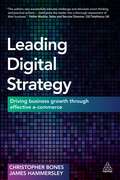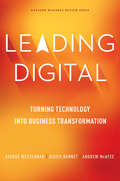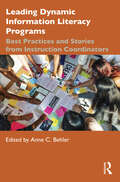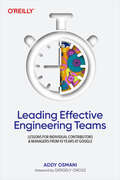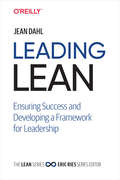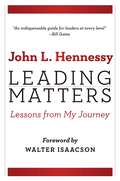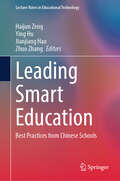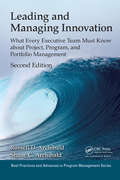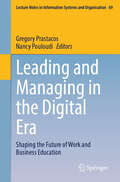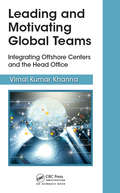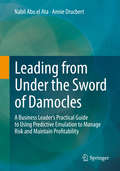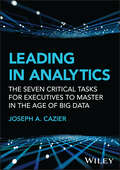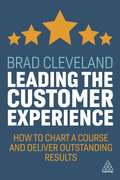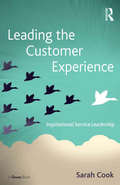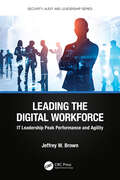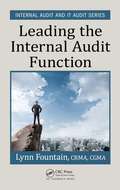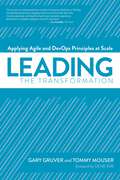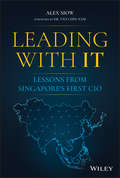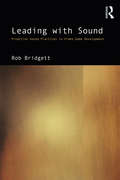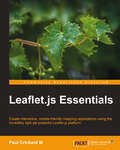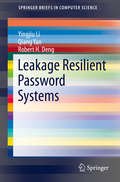- Table View
- List View
Leading Connected Classrooms: Engaging the Hearts and Souls of Learners
by Dr Robert W. DillonHelp your students find and keep the joy in learning! When creative use of technology meets outstanding teaching, incredible learning happens. In this inspiring guide, digital educator and principal Robert Dillon shows readers how to: Use student engagement to promote authentic learning Learn from 16 innovative contributing educators Implement new technology resources and strategies for all classrooms and grade levels Help students build critical thinking skills and gain confidence in their own unique voices
Leading Digital Strategy
by Christopher Bones James HammersleyFor a business to thrive competitively in today's marketplace, it needs to have an effective e-commerce channel. Getting it right opens up new markets and opportunities; getting it wrong leads to declining revenues and profitability. To ensure effectiveness, business leaders and decision-makers must understand how e-commerce channels work to make the best strategic choices for their business. Drawing on experience in consulting to large complex organisations and ground-breaking primary research with senior executives from leading corporations, Leading Digital Strategy creates a convincing case for action and offers practical strategies, methodologies and models to improve the effectiveness of a company's online offering. It explores how to align organizational structure with wider goals and implement a customer-centric culture. With coverage of the key digital trends, tools and technologies affecting business today, it provides a practical framework for multi-channel success. This book challenges leaders to become as fluent and creative in digital as they are in finance, sales and marketing, and equips them to choose the right strategy and the right people to make it happen. With strategies for improved operational performance and enhanced engagement from senior management, Leading Digital Strategy gives readers the power to drive forward effective digital initiatives and realize rewarding opportunities for change.
Leading Digital: Turning Technology into Business Transformation
by George Westerman Andrew Mcafee Didier BonnetLeading Digital makes the provocative argument that the next imminent phase of digital technology adoption - driven by the convergence of mobility, analytics, social media, cloud computing, and embedded devices - will make everything that’s happened so far look like a prelude. The authors, a trio of highly regarded thought leaders on corporate digital transformation, say changes in the digital realm so far have focused on high tech and media companies - but there’s still a whopping 94% of the business economy that needs to change. This book will show them how. George Westerman of MIT, Didier Bonnet of Capgemini Consulting, and Andrew McAfee, also at MIT, say there is opportunity for these businesses to learn from those that have already mastered the digital landscape. Based on a study of more than 400 large, mainstream firms in every industry around the globe, the authors usefully break down how these organizations have used their own digital transformation to gain strategic, competitive advantage. Readers will learn how these digital leaders have transformed their businesses through smart and rigorous digital investments, and through smart and effective leadership of the change. Leading Digital offers practical, real-life tested frameworks that can be instantly applied. Case studies include Nike, Caesars, Burberry, Asian Paints, Pages Jaunes, Codelco, and more.
Leading Dynamic Information Literacy Programs: Best Practices and Stories from Instruction Coordinators
by Anne C. BehlerLeading Dynamic Information Literacy Programs delves into the library instruction coordinator’s work. Each chapter is written by practicing coordinators, who share their experiences leading information literacy programs that are nimble, responsive, and supportive of student learning. The volume discusses the work of instruction coordinators within five thematic areas: Claiming our Space: Library Instruction in the Landscape of Higher Education; Moving and Growing Together; Curriculum Development; Meaningful Assessment; and Leading Change. Readers will gain insight from their colleagues’ advice for situating information literacy within the higher education institution, developing meaningful curricula, and using assessment in productive ways. Many of the stories represent a departure from traditional models of library instruction. In addition, this book is sure to spark inspiration for innovative approaches to program leadership and development, including strategies for growing communities of practice. From leadership skills and techniques, methods for cultivating shared values, pedagogical approaches, team building, assessment strategies – and everything in between – the aspiring or practicing instruction coordinator has much to gain from reading this work.
Leading Effective Engineering Teams: Lessons for Individual Contributors and Managers from 10 Years at Google
by Addy OsmaniIn this insightful and comprehensive guide, Addy Osmani shares more than a decade of experience working on the Chrome team at Google, uncovering secrets to engineering effectiveness, efficiency, and team success. Engineers and engineering leaders looking to scale their effectiveness and drive transformative results within their teams and organizations will learn the essential principles, tips, and frameworks for building highly effective engineering teams.Osmani presents best practices and proven strategies that foster engineering excellence in organizations of all sizes. Through practical advice and real-world examples, Leading Effective Engineering Teams empowers you to create a thriving engineering culture where individuals and teams can excel. Unlock the full potential of your engineering team and achieve unparalleled success by harnessing the power of trust, commitment, and accountability.With this book, you'll discover:The essential traits for engineering effectiveness and the pitfalls to avoidHow to cultivate trust, commitment, and accountability within your teamStrategies to minimize friction, optimize career growth, and deliver maximum valueThe dynamics of highly successful engineering teams and how to replicate their achievementsHow to implement a systems thinking approach for everyday problem-solving and decision-makingSelf-advocacy techniques to enhance your team's visibility and recognition within the organization
Leading Lean: Ensuring Success and Developing a Framework for Leadership
by Jean DahlCompanies from startups to corporate giants face massive amounts of disruption today. Now more than ever, organizations need nimble and responsive leaders who know how to exploit the opportunities that change brings. In this insightful book, Jean Dahl, a senior executive and expert in the Lean mindset and its methods, demonstrates why you need to embrace Modern Lean principles and thinking to redefine leadership in this age of digital disruption in order to continuously evolve the Lean enterprise.Drawing on nearly three decades of corporate and consulting experience, Ms. Dahl lays out a new holistic framework for developing Modern Lean leaders. Through personal experiences and compellingreal-world case studies, she explains specific steps necessary for you and your company to proactively understand and respond to change.Understand the leadership challenges Lean leaders face in our 21st century global economyExplore the six dimensions of the Modern Lean Framework™Learn and apply the nine steps necessary to become a Lean leaderUse Modern Lean methods to build a culture of continuous learning that can be sustained and maintained within your organizationSeize competitive advantage by embracing Modern Lean to tbuild an enterprise that understands how to respond to disruption
Leading Matters: Lessons from My Journey
by Walter Isaacson John L. HennessyIn Leading Matters, current Chairman of Alphabet (Google's parent company), former President of Stanford University, and "Godfather of Silicon Valley," John L. Hennessy shares the core elements of leadership that helped him become a successful tech entrepreneur, esteemed academic, and venerated administrator. Hennessy's approach to leadership is laser-focused on the journey rather than the destination. Each chapter in Leading Matters looks at valuable elements that have shaped Hennessy's career in practice and philosophy. He discusses the pivotal role that humility, authenticity and trust, service, empathy, courage, collaboration, innovation, intellectual curiosity, storytelling, and legacy have all played in his prolific, interdisciplinary career. Hennessy takes these elements and applies them to instructive stories, such as his encounters with other Silicon Valley leaders including Jim Clark, founder of Netscape; Condoleezza Rice, former U.S. Secretary of State and Stanford provost; John Arrillaga, one of the most successful Silicon Valley commercial real estate developers; and Phil Knight, founder of Nike and philanthropist with whom Hennessy cofounded Knight-Hennessy Scholars at Stanford University. Across government, education, commerce, and non-profits, the need for effective leadership could not be more pressing. This book is essential reading for those tasked with leading any complex enterprise in the academic, not-for-profit, or for-profit sector.
Leading Smart Education: Best Practices from Chinese Schools (Lecture Notes in Educational Technology)
by Haijun Zeng Ying Hu Zhuo Zhang Jianjiang HaoThis book focuses on best practices in smart education in Chinese schools. It showcases the achievements of Chinese schools in smart education since the comprehensive implementation of the educational digital transformation in China. These selected case studies explore smart education practices from various perspectives, such as innovative practices in teaching and learning, the construction and application of digital platforms, resources, and tools, smart educational and teaching evaluation, and the construction of smart campuses. It enriches understanding of the current status of smart education in Chinese schools and is a useful reference for researchers, teachers, policymakers, and school administrators across the globe.
Leading and Managing Innovation: What Every Executive Team Must Know about Project, Program, and Portfolio Management, Second Edition (Best Practices in Portfolio, Program, and Project Management #22)
by Russell D. Archibald Shane ArchibaldThe primary cause of many project failures is that responsible executives, because of their lack of knowledge in project management, fail to demand that their managers and staff properly utilize the well-proven best practices, processes, systems, and tools that are now available in this field. This book remedies this situation by providing executives at all levels with the understanding and knowledge needed to best take advantage of the power of effective project management and thereby lead and manage innovations within their enterprise. In Leading and Managing Innovation: What Every Executive Team Must Know about Project, Program, and Portfolio Management, Second Edition, the authors present concise descriptions of The key concepts underlying project and program management The important characteristics of projects and programs How projects and programs are best governed and managed How to determine if the desired benefits have actually been achieved The book presents a list of 31 reasonable demands that executives can and must place on their staff members to ensure excellence in the way their programs and projects are created, selected for funding, planned, and executed. Placing these demands communicates to the entire enterprise that top management understands what it takes to achieve the best performance possible and fully supports the continuous improvement needed to ensure continued success. Leading and Managing Innovation explains how to measure the project management maturity level of an enterprise, benchmark against competitors, and identify where project management improvements are required. It discusses the many ways that an enterprise can derive substantial success and competitive advantage from increasing its project management maturity level. A helpful quick reference summary of all of the book’s key information is included in the final chapter. Armed with this information, you will be well-qualified to give excellent direction to your managers and staff to ensure that your vital capability in the field of project management—and how you manage innovation—is equal to or better than that of your competitors.
Leading and Managing in the Digital Era: Shaping the Future of Work and Business Education (Lecture Notes in Information Systems and Organisation #69)
by Nancy Pouloudi Gregory PrastacosRapidly emerging digital technologies such as artificial intelligence, robotics, the Internet of Things, blockchain, and virtual and augmented reality are driving profound changes in the workplace and society. These technologies are radically transforming areas of cognitive and physical work while opening up new opportunities for complex decision-making and increased efficiency. As a result, a new set of skills and a new style of leadership is required, where digital savviness is essential, together with an increased focus on collaboration, transparency, entrepreneurship, diversity, and inclusion. This book, organized in six parts, presents key developments of the digital age in leadership, management, the future of work, and business education. Part I, Governance in the Digital Era, sets the scene by reviewing the challenges that the digital era presents for policy makers at national and global levels. This research is complemented by research at the organizational level in Part II, Strategy and Entrepreneurship in the Digital Era, that discusses strategic issues that organizations of different sizes and levels of digital maturity face. Part III, Innovation and digital transformation, presents examples from different sectors, where AI and other innovative technologies are integrated in business. Part IV, The Future of Work, focuses on the changing conditions of workspaces and their implications for human resource management and the future of work. Part V, Leadership and Skills for the Digital Era, explores the impact of this changing business and societal landscape and studies the leadership style and skills needed in these conditions. Finally, Part VI, The Future of Business Education, studies how such skills and leadership may be cultivated in business education and draws lessons for the future. The book is based on a selection of the best papers on this topic presented at the international conference LMDE held in Athens, Greece, in June 2023.
Leading and Motivating Global Teams: Integrating Offshore Centers and the Head Office (Best Practices in Portfolio, Program, and Project Management)
by Vimal Kumar KhannaThis book provides techniques for offshore center managers and head office managers to motivate and manage globally distributed teams, which are spread across the offshore center and the head office, and thereby achieve higher productivity. Readers learn how to integrate the offshore center with the head office to make the offshore team an extension of the head office. While integrating teams with the head office, offshore center managers can still retain independence and authority to meet team aspirations. <P><P>The book provides insight into devising new organizational structures to balance the authority and responsibilities of offshore center and head office managers. Head office managers responsible for managing globally distributed projects learn how to achieve a higher success rate on their projects and be better rewarded for their efforts in offshoring. Head office managers also learn techniques to make more significant contributions in their expatriate assignments to the offshore center. <P><P>This book guides both the offshore center managers and the head office managers to fully realize the potential of the offshore center, which can result in higher revenues and profitability.
Leading and Motivating Global Teams: Integrating Offshore Centers and the Head Office (Best Practices in Portfolio, Program, and Project Management)
by Vimal Kumar KhannaThis book provides techniques for offshore center managers and head office managers to motivate and manage globally distributed teams, which are spread across the offshore center and the head office, and thereby achieve higher productivity. Readers learn how to integrate the offshore center with the head office to make the offshore team an extension of the head office. While integrating teams with the head office, offshore center managers can still retain independence and authority to meet team aspirations. The book provides insight into devising new organizational structures to balance the authority and responsibilities of offshore center and head office managers. Head office managers responsible for managing globally distributed projects learn how to achieve a higher success rate on their projects and be better rewarded for their efforts in offshoring. Head office managers also learn techniques to make more significant contributions in their expatriate assignments to the offshore center. This book guides both the offshore center managers and the head office managers to fully realize the potential of the offshore center, which can result in higher revenues and profitability.
Leading from Under the Sword of Damocles: A Business Leader's Practical Guide To Using Predictive Emulation To Manage Risk And Maintain Profitability
by Nabil Abu el Ata Annie DrucbertGlobalization trends and the rapid pace of technological innovations have introduced unprecedented change and uncertainty. For unprepared businesses, the drivers of the Fourth Industrial Revolution will become a constant source of surprise and crises will unfold at an ever-increasing rate. To thrive under these conditions, companies must adopt new risk management technologies and practices that enable business leaders to better anticipate and adjust to changing dynamics.This book helps readers understand how algorithm-based predictive and prescriptive analytics principles can be used to control risk in today’s dynamic business environment. It serves as a reference guide for business leaders and risk management practitioners of companies that are global in reach or operate dynamically complex systems. Using the technological and scientific innovations presented in this book, business leaders can gain a wider understanding of risk and prescriptively determine which actions are necessary to ensure the business is optimally positioned to meet its stated long-term goals and objectives.Case studies show how the presented methods can be practically applied to preemptively expose risks and support decisions to optimize, transform or disrupt current business models, strategies, organizational structure and information systems when necessary to maintain a market position or outperform competitors.These methods have been proven through hundreds of client cases. By using mathematical emulation to link business risks to strategic imperatives, it becomes possible to achieve a higher annual profit margin and better growth. As we enter the Fourth Industrial Revolution, companies that are able to expose risks caused by dynamic complexity and maintain the alignment between the goals of the business and operational execution will be better prepared to make the shifts necessary for long-term success and keep the business moving toward its goals.
Leading in Analytics: The Seven Critical Tasks for Executives to Master in the Age of Big Data (Wiley and SAS Business Series)
by Joseph A. CazierA step-by-step guide for business leaders who need to manage successful big data projects Leading in Analytics: The Critical Tasks for Executives to Master in the Age of Big Data takes you through the entire process of guiding an analytics initiative from inception to execution. You’ll learn which aspects of the project to pay attention to, the right questions to ask, and how to keep the project team focused on its mission to produce relevant and valuable project. As an executive, you can’t control every aspect of the process. But if you focus on high-impact factors that you can control, you can ensure an effective outcome. This book describes those factors and offers practical insight on how to get them right. Drawn from best-practice research in the field of analytics, the Manageable Tasks described in this book are specific to the goal of implementing big data tools at an enterprise level. A dream team of analytics and business experts have contributed their knowledge to show you how to choose the right business problem to address, put together the right team, gather the right data, select the right tools, and execute your strategic plan to produce an actionable result. Become an analytics-savvy executive with this valuable book. Ensure the success of analytics initiatives, maximize ROI, and draw value from big data Learn to define success and failure in analytics and big data projects Set your organization up for analytics success by identifying problems that have big data solutions Bring together the people, the tools, and the strategies that are right for the jobBy learning to pay attention to critical tasks in every analytics project, non-technical executives and strategic planners can guide their organizations to measurable results.
Leading the Customer Experience: How to Chart a Course and Deliver Outstanding Results
by Brad ClevelandMany organizations and leaders struggle to respond effectively to fast-evolving customer expectations driven by innovations in products, services and technologies such as AI and mobile. Failing to build the necessary strategy, culture and processes, they suffer from high costs, dissatisfied customers and brand damage. The mandate to get customer experience right is real and urgent. Leading the Customer Experience is a guide to shaping experiences that win loyalty and deliver outstanding business results. It provides a bold, step-by-step approach that will get you and your team pointed in the right direction. And equipped to make sound decisions along the way. Leading the Customer Experience is easy to understand and imminently practical. It is based on the author's extensive experience both as a founding partner of one of the world's most influential customer management organizations, and his work with B2B and B2C organizations in the private and public sectors.The author's down-to-earth explanations cut through jargon and clutter, while stories and examples bring important principles to life. Leading the Customer Experience is relatable to anyone leading, managing or aspiring to better understand customer experience.
Leading the Customer Experience: Inspirational Service Leadership
by Sarah CookLeading the Customer Experience explores the relationship between leadership behaviour and exceptional service. Most organisation’s strategic aims and goals centre on the delivery of excellent service. Loyal customers not only keep buying from a company but also recommend the business to others. It is clear that managers and leaders throughout an organisation have a key influence on the experience that customers receive. How leaders behave has a direct impact on their team member’s motivation to go the extra mile to deliver excellent service for the customer. Sarah Cook’s vision for Leading the Customer Experience is to provide practical advice, tools and techniques for managers in how to effectively lead and motivate their team to deliver the best possible customer service. This book encapsulates her research on the behaviours of leaders who successfully create an environment where employees deliver exceptional service and she brings a pragmatic and business focused approach to the topic. Each chapter contains a variety of case study examples from businesses in UK and Europe, Asia Pacific, US and BRIC countries. These include service organisations in the financial sector, manufacturing, hospitality, transport, healthcare, public and third sectors.
Leading the Digital Workforce: IT Leadership Peak Performance and Agility (Security, Audit and Leadership Series)
by Jeffrey W. BrownFuture IT leaders won't be technology leaders, they'll be business leaders who understand technology. Leading the Digital Workforce takes a fresh look at technology leadership, exploring how to lead and manage in today’s digital workplace where the pace of change is exponential. This book walks you through building personal resiliency and avoiding stress and burnout to creating a strategy, building a high-performance team, and examining how technology will change the workforce of the future. Technology leadership requires a unique set of skills, which is why traditional leadership approaches don't always work. This book provides actionable advice on how to create a culture of innovation while driving successful change initiatives. Leading the Digital Workforce provides strategies for empowering people, optimizing processes, and inspiring innovation. This book offers insights into managing change, leveraging technology, and building strong relationships within your organization, including how to understand and work with company culture. Finally, it shares strategies for using technology and innovation to create a competitive edge to unlock new opportunities. Leading the Digital Workforce is essential reading for IT leaders who want to develop their skills, stay ahead of the digital curve, and lead their organizations into the future. No matter if you’re a new IT leader, an aspiring one, or a seasoned leader who’s been at it for years, there’s something in this book that will help you level up your game.
Leading the Internal Audit Function (ISSN #1)
by Lynn FountainIn this book, the author presents lessons learned from her extensive experience as a CAE to help internal auditors understand the challenges, issues, and potential alternative solutions when executing the role. The book explains how to clarify management expectations for the internal audit and balance those expectations with the IIA Standards. It examines the concept of risk-based auditing and explains how to determine whether management and the internal audit team have the same objectives. It also looks at the internal auditor's role in corporate governance and fraud processes.
Leading the Transformation: Applying Agile and DevOps Principles at Scale
by Gary Gruver Tommy MouserSoftware is becoming more and more important across a broad range of industries, yet most technology executives struggle to deliver software improvements their businesses require.Leading-edge companies like Amazon and Google are applying DevOps and Agile principles to deliver large software projects faster than anyone thought possible. But most executives don't understand how to transform their current legacy systems and processes to scale these principles across their organizations.Leading the Transformation is executive guide, providing a clear framework for improving development and delivery. Instead of the traditional Agile and DevOps approaches that focus on improving the effectiveness of teams, this book targets the coordination of work across teams in large organizations—an improvement that executives are uniquely positioned to lead.
Leading with IT: Lessons from Singapore's First CIO
by Alex SiowExplore the insights of a world-leading CIO as he expounds on the challenges faced by technology executives and how to overcome them As the pace of change in business continues to rapidly accelerate, Chief Information Officers and Chief Technology Officers are often left with accountability for future-proofing their organizations. Renowned professor, executive, and author Alex Siow shows you how you can meet that challenge while managing the information overload that often accompanies these positions. In Leading with IT: Lessons from Singapore’s First CIO, the author uses his expansive and impressive experience in academia and industry to lead you down a path to achieving success as a CIO or CTO. Filled with practical tips, case studies, and personal insights, the book discusses: The management of legacy information and telecommunications technology The information overload often suffered by technology executives How to motivate and mentor a workforce How to manage change effectively The fostering of innovation The future of money, work, and artificial intelligence Perfect for CIOs, CTOs, and the executives, managers, and employees who work with and for them, Leading with IT delivers an engaging and insightful exploration of what it takes to achieve astounding results at the intersection of technology and business.
Leading with Sound: Proactive Sound Practices in Video Game Development
by Rob BridgettLeading with Sound is the must-have companion guide to working on video game projects. Focused on the creative, collaborative, philosophical and organizational skills behind game sound and eschewing the technical, this book celebrates the subjects most essential to leading with sound in video game development at any level. Refuting the traditional optics of sound as a service in favour of sound as a pro-active visionary department, , this book examines each of the four food-groups of dialogue, sound design, music and mix, not through the usual technical and production lenses of ‘how’ and ‘when’, but the essential lens of ‘why’ that enables leadership with sound. Leading with Sound is essential reading for aspiring sound designers, inside and outside of the classroom, as well as experienced professionals in the game industry.
Leaflet.js Essentials
by Paul Crickard IIIIf you are a web developer working with geospatial concepts and mapping APIs, and you want to learn Leaflet to create mapping solutions, this book is for you. You need to have a basic knowledge of working with JavaScript and performing web application development.
League of Legends: Realms of Runeterra (Official Companion)
by Riot GamesUnlock the mysteries and magic within League of Legends, one of the world's most popular video games, in this encyclopedic and collectible companion book that explores the game's epic lore. Embark on a journey through the realms of Runeterra in this first-ever collectible companion book, published to celebrate the game's tenth anniversary. Spanning the farthest reaches of this universe and venturing into uncharted territory, this encyclopedic compendium connects players to the rich storytelling that inspires all the action. Inside, you'll find:An expedition through eleven regions, chronicling conflicts, entrenched rivalries, and covert alliancesHundreds of illustrations, including never-before-seen maps and artworkInsights into the heroes, flora, fauna, architecture, politics, and technologies from all corners of this worldOriginal narratives that bring the cultures of Runeterra to lifeLeague of Legends is an online game played by millions of people around the world, offering endless engagement with an expanding roster of champions, frequent updates, and a thriving esports scene. This volume is an essential reference for fans everywhere.
Leakage Resilient Password Systems
by Yingjiu Li Qiang Yan Robert H. DengThis book investigates tradeoff between security and usability in designing leakage resilient password systems (LRP) and introduces two practical LRP systems named Cover Pad and ShadowKey. It demonstrates that existing LRP systems are subject to both brute force attacks and statistical attacks and that these attacks cannot be effectively mitigated without sacrificing the usability of LRP systems. Quantitative analysis proves that a secure LRP system in practical settings imposes a considerable amount of cognitive workload unless certain secure channels are involved. The book introduces a secure and practical LRP system, named Cover Pad, for password entry on touch-screen mobile devices. Cover Pad leverages a temporary secure channel between a user and a touch screen which can be easily realized by placing a hand shielding gesture on the touch screen. The temporary secure channel is used to deliver a hidden message to the user for transforming each password symbol before entering it on the touch screen. A user study shows the impact of these testing conditions on the users' performance in practice. Finally, this book introduces a new LRP system named ShadowKey. Shadow Key is designed to achieve better usability for leakage resilient password entry. It leverages either a permanent secure channel, which naturally exists between a user and the display unit of certain mobile devices, or a temporary secure channel, which can be easily realized between a user and a touch screen with a hand-shielding gesture. The secure channel protects the mappings between original password symbols and associated random symbols. Unlike previous LRP system users, Shadow Key users do not need to remember anything except their passwords. Leakage Resilient Password Systems is designed for professionals working in the security industry. Advanced-level students studying computer science and electrical engineering will find this brief full of useful material.
Leaks, Hacks, and Scandals: Arab Culture in the Digital Age (Translation/transnation Ser. #40)
by Tarek El-ArissHow digital media are transforming Arab culture, literature, and politicsIn recent years, Arab activists have confronted authoritarian regimes both on the street and online, leaking videos and exposing atrocities, and demanding political rights. Tarek El-Ariss situates these critiques of power within a pervasive culture of scandal and leaks and shows how cultural production and political change in the contemporary Arab world are enabled by digital technology yet emerge from traditional cultural models.Focusing on a new generation of activists and authors from Egypt and the Arabian Peninsula, El-Ariss connects WikiLeaks to The Arabian Nights, Twitter to mystical revelation, cyberattacks to pre-Islamic tribal raids, and digital activism to the affective scene-making of Arab popular culture. He shifts the epistemological and historical frameworks from the postcolonial condition to the digital condition and shows how new media challenge the novel as the traditional vehicle for political consciousness and intellectual debate.Theorizing the rise of “the leaking subject” who reveals, contests, and writes through chaotic yet highly political means, El-Ariss investigates the digital consciousness, virality, and affective forms of knowledge that jolt and inform the public and that draw readers in to the unfolding fiction of scandal.Leaks, Hacks, and Scandals maps the changing landscape of Arab modernity, or Nahda, in the digital age and traces how concepts such as the nation, community, power, the intellectual, the author, and the novel are hacked and recoded through new modes of confrontation, circulation, and dissent.

